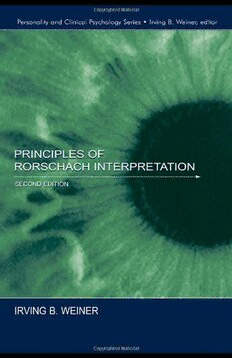
Principles of Rorschach Interpretation (Lea's Personality and Clinical Psychology) PDF
448 Pages·2003·3.329 MB·English
Most books are stored in the elastic cloud where traffic is expensive. For this reason, we have a limit on daily download.
Preview Principles of Rorschach Interpretation (Lea's Personality and Clinical Psychology)
Description:
This second edition of Irving Weiner's classic comprehensive, clinician-friendly guide to utilizing the Rorschach for personality description has been revised to reflect both recent modifications in the Rorschach Comprehensive System and new evidence concerning the soundness and utility of Rorschach assessment. It integrates the basic ingredients of structural, thematic, behavioral, and sequence analysis strategies into systematic guidelines for describing personality functioning. It is divided into three parts. Part I concerns basic considerations in Rorschach testing and deals with conceptual and empirical foundations of the inkblot method and with critical issues in formulating and justifying Rorschach inferences. Part II is concerned with elements of interpretation that contribute to thorough utilization of data in a Rorschach protocol: the Comprehensive System search strategy; the complementary roles of projection and card pull in determining response characteristics; and the interpretive significance of structural variables, content themes, test behaviors, and the sequence in which various response characteristics occur. Each of the chapters presents and illustrates detailed guidelines for translating Rorschach findings into descriptions of structural and dynamic aspects of personality functioning. The discussion throughout emphasizes the implications of Rorschach data for personality assets and liabilities, with specific respect to adaptive and maladaptive features of the manner in which people attend to their experience, use ideation, modulate affect, manage stress, view themselves, and relate to others. Part III presents 10 case illustrations of how the interpretive principles delineated in Part II can be used to identify assets and liabilities in personality functioning and apply this information in clinical practice. These cases represent persons from diverse demographic backgrounds and demonstrate a broad range of personality styles and clinical issues. Discussion of these cases touches on numerous critical concerns in arriving at different diagnoses, formulating treatment plans, and elucidating structural and dynamic determinants of behavior.
See more
The list of books you might like
Most books are stored in the elastic cloud where traffic is expensive. For this reason, we have a limit on daily download.
